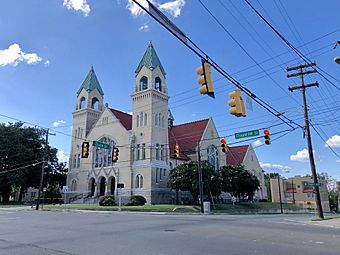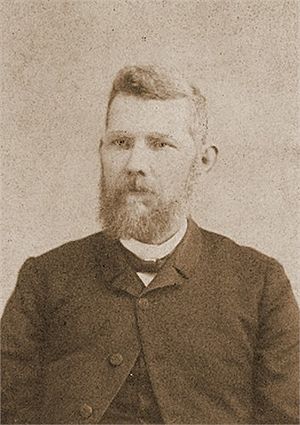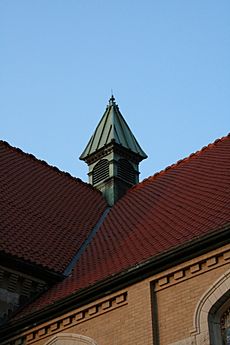Duke Memorial United Methodist Church facts for kids
Quick facts for kids |
|
|
Duke Memorial United Methodist Church
|
|

Duke Memorial United Methodist Church from W Chapel Hill Street
|
|
| Location | 504 W. Chapel Hill St., Durham, North Carolina |
|---|---|
| Area | 3 acres (1.2 ha) |
| Built | 1907 |
| Architect | Kramer, George W.; Underwood, Norman |
| Architectural style | Gothic, Romanesque |
| MPS | Durham MRA |
| NRHP reference No. | 85001781 |
| Added to NRHP | August 11, 1985 |
Duke Memorial United Methodist Church is a historic Methodist church located at 504 W. Chapel Hill Street in Durham, North Carolina. It was first started in 1886. The church grew as Durham became a busy center for making textiles and tobacco. It has always had a strong connection with Duke University, which was once called Trinity College. Many important people from Durham's education and industry were members of this church. It is named after Washington Duke, a famous tobacco businessman and giver, and his sons, who helped build the church.
Contents
How the Church Began
Duke Memorial United Methodist Church started from Durham's first Methodist group. Members of the original Durham Methodist church, later called Trinity Methodist Church, saw that new churches were needed. This was because the city was growing fast, especially on its east and west sides. Durham's population was increasing quickly due to the booming cotton and tobacco industries. Companies like Washington Duke, Sons & Co. and W.T. Blackwell & Co., along with cotton firms, brought many new workers to the city.
Washington Duke and other leaders wanted Durham to be more than just a rich city. They hoped it would also be a place with culture. Durham was growing very fast, and they wanted to make sure it became an organized and civilized city. So, they encouraged building churches and schools, like Trinity College and this church.
In 1885, some members of the Durham Methodist Church formed a group to plan a new church. This church was already being called the "West End Church." Businessmen like Washington Duke were part of this group. They decided to build the church and got promises of money for its construction.
In 1885, Reverend Amos Gregson became the pastor for the West End Church. Even though the church didn't have its own building yet, Reverend Gregson held the first services on May 2, 1886, at the Washington Duke, Sons & Co Tobacco Factory. This new group also started the Bethany Sunday School, which became very popular. Many Durham businessmen, like B.N. Duke, were active leaders in the Sunday School. Most members worked in the factory, but some, like Washington Duke himself, also joined.
On October 10, 1886, the Sunday school moved into the new church building. This building was 40 by 70 feet and made of red brick. It was located at the corner of Main and Gregson Streets. Washington Duke's oldest son, Brodie L. Duke, gave the land for the church. On April 24 of the next year, the Main Street Methodist Church was officially opened. The church continued to gain members. In 1889 alone, 138 new members joined.
Church Growth and Trinity College
The year 1892 was important for both the church and Durham. Trinity College moved to Durham, largely thanks to Washington Duke. Soon after, the college became closely connected to the Main Street Church. Many professors from Trinity College were active members of the church. Dr. W. I. Cranford, a popular professor, attracted many students to his Sunday school class. Professors J.S. Bassett and R.L. Flowers were also active members and teachers. Dr. John Carlisle Kilgo, a Methodist minister, became president of the college in 1894. He often preached at the church.
For the next ten years, the church kept growing. By 1904, it had 640 members. Washington Duke was very involved in the church's plans and operations until he passed away in 1905. When the church had money problems, he would often pay off the debt himself.
The Main Street church also started a good library for its members. Soon, there wasn't enough room for all the books or for all the members. As Durham's population grew, so did church attendance. Sunday school classes were too crowded, and the main church area couldn't fit everyone comfortably. It became clear that the Main Street Church building, after only twenty years, was too small. The building was sold in 1906.
The Memorial Church
In the fall of 1906, the church committee bought the land where Duke Memorial UMC stands today. This land is at the corner of Duke and Chapel Hill Streets. Work on the new church's foundation began on January 1, 1907. As building started, the church's name changed from "Main Street Methodist Episcopal Church, South" to "Memorial Methodist Episcopal Church, South."
Mr. George W. Kramer from New York City was chosen as the architect. The church committee planned for the new building to be made of stone, in a Gothic style, and to cost about $90,000. James B. and Benjamin N. Duke each promised $30,000. Money was also promised for an organ and church bells.
The building was first used for a Sunday service on July 19, 1908. However, the service was held in the Sunday school area because the main church area was not finished yet. The church had 498 members then. The main church area was finally ready on June 2, 1912. By that time, the church had an impressive 709 members.
Connection to Duke University
Just like with Main Street Church, Trinity College was a very important part of the church. When Trinity College became Duke University in 1924, this strong connection continued. Many university leaders were members of the church. Presidents J.C. Kilgo, William Preston Few, R.L. Flowers, and Arthur Hollis Edens all belonged to the church. This shows how important the church was to Durham's educated and wealthier residents. Students from Trinity College also attended, filling the Sunday school classes.
In June 1913, church members met to deal with the money still owed for the building. Following his father's example, B.N. Duke offered to pay off the remaining $19,000 debt. He asked the church members to raise money for the interest and to finish the basement. On June 7, 1914, the church was officially dedicated.
James B. Duke passed away in October 1925. Soon after, the church leaders approved another name change. The church became "Duke Memorial Methodist Episcopal Church, South." This change recognized the big role Washington Duke had played in building the first church and how his sons helped build the new one.
From 1930 to 1931, a new building for the elementary Sunday school was built in the same style as the church. In 1939, the church's name became "Duke Memorial Methodist Church." This happened when the Methodist Episcopal Church and the Methodist Episcopal Church, South joined together. In 1963, the church started building a completely new education building. This building was officially opened on August 23, 1964. With this addition, the church looked much like it does today.
The last name change happened in 1968, to "Duke Memorial United Methodist Church." This was when the Methodist Church and the Evangelical United Brethren Churches joined to form the United Methodist Church. The church is still active today and helps the Durham community in many ways.
The Duke Family's Support
The church's name change in 1925 made it clear: this church existed because of the Duke family.
Washington Duke took his faith seriously, and it guided much of his giving. He wanted to help the spiritual well-being of those who worked in his tobacco factory and the wider Durham community. He believed in helping to make the world better. Washington Duke was very important in building the Main Street Church and keeping it running until he passed away in May 1905. In 1889, six Duke family members were church members, including James B., B.N., and Sarah P. Duke. Three of the seven members on the board of trustees were Washington Duke, Brodie L. Duke, and B.N. Duke.
Outside of the church, Washington Duke made the largest gift of money to education by one person in North Carolina at that time. He gave $500,000 to Trinity College. As Durham grew into a modern city, men like Washington Duke hoped to build a better community through religious activities and education.
Washington Duke's sons continued his legacy. The Duke family always gave special support to Main Street Church and Memorial Church. They also gave generously to other churches, often Methodist churches in smaller towns in North Carolina. They frequently gave money for simple repairs to church buildings and to help start new churches. B.N. Duke was especially interested in helping new churches begin and grow.
In 1924, James B. Duke created the Duke Endowment with $40 million. This not only established Duke University as it is known today, but it also set aside a part of the endowment's income to continue the yearly donations he had started in 1915. This included funding for building rural churches and orphanages in the state. The Duke Endowment still supports Methodist churches in North Carolina and their pastors, as well as several universities.
Their older brother, Brodie L. Duke, gave important pieces of land to both Main Street Church and for a home for the church leader in Durham. Generations of Dukes have continued their family's support for the church, both financially and by attending services.
The Duke family's strong belief in Methodism and their desire to help others is clear. Duke Memorial United Methodist Church, as it stands today, is a visible example of the Duke family's dedication to giving back and to the Methodist Church.
Church Building Features
The church building's frame is supported by strong steel beams. The outside is made of white pressed brick with granite decorations. It sits on a granite foundation and has a red tile roof. The building's style is called Gothic Revival. You can see this clearly in the stone work around the entrance and the windows. However, the brickwork of the two four-story towers is in the Romanesque Revival style. One of the towers has a working set of 10 bells called a chime.
The main church area, called the sanctuary, has two stories and is shaped like a cross. It is decorated with Gothic Revival woodwork. The decorative supports hide the steel beams inside. The two buildings added later, the elementary building (1931) and the education building (1963), are connected to the sanctuary by a walkway. They also have the same Gothic Revival style on the outside.
The church's beautiful stained glass windows, put in place in 1911, are very special. Most of the windows show people from the Bible and scenes from the life of Christ. The large window facing Chapel Hill Street is different. It shows John Wesley preaching on his father's tomb after he was not allowed to preach in the Epworth church in England.
In 1970-71, the sanctuary was updated, and a new organ was installed. In 1982, the bell tower was renovated. The bells were repaired, and the playing mechanism was fixed. In January 1986, the church was added to the National Register of Historic Places, recognizing its importance.





